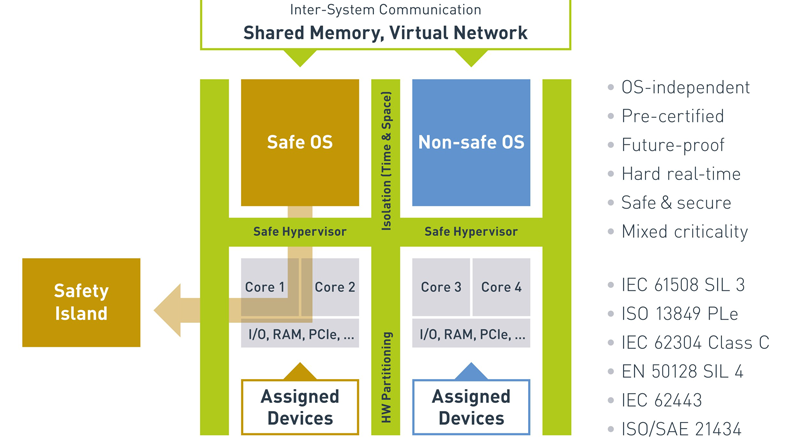Real-Time Systems Safe Hypervisor running on Intel Atom x6000E Series enables new functional safety-compliance capabilities
Real-Time Systems (RTS) announces the upcoming availability of its new RTS Safe Hypervisor. The RTS Safe hypervisor will be an OS-independent functional safety certified Type 1 hypervisor to target mixed-critical workloads based on x86 multicore processor technologies and will be available worldwide.
The new RTS Safe Hypervisor will be delivered as a complete OEM package, bundling the certified real-time hypervisor with functionally safe and non-safe virtual machines and a certified safe OS such as the Linux-based Zephyr or QNX. This bundle targets any off-the-shelf or custom-specific embedded computing platform equipped with FuSa-capable x86 processors. The first implementations will be based on Intel Atom x6000E Series processors with integrated Intel Safety Island and 11th Generation Intel Core processors.
“We want to ensure that engineers get the most efficient route to fully functional-safety-compliant applications by utilizing pre-certified platforms. Safe real-time hypervisor technology is the key to tying everything together, from safe hardware, safe Type 1 grade virtual machines, and safe OSes to non-safe domains running multi-purpose OSes. In the end, application engineers only need to take care of their safety-critical application part to gain functional safety certification. This is ultra-convenient in an IoT- and AI-driven decade, where many innovations are emerging in the autonomous vehicle and collaborative robot sectors, for example. Here the core functions must comply with functional safety standards. The non-safe part of the bundle, on the other hand, can be modified and updated as needed without affecting the functionally safe parts in any way. And the real sweet spot for engineers is that they can utilize standard x86 technologies,” says Michael Reichlin, CEO at Real-Time Systems, to explain the sales strategy for the new RTS Safe Hypervisor.
Typical mixed-critical applications include complete solutions on a single embedded computing platform that combine real-time enabled safe controls with non-safety applications – such as GUIs, AI logic or vision, and situational awareness systems. With the Industry 4.0 trend, IoT gateways are becoming increasingly embedded. Integrated gateways are required, for superordinated control logic over real-time 5G and/or for anything related to the IT/OT fusion trend to enable predictive maintenance and new business models via agile subscriptions with pay-per-use and usage-based pricing.
Benefits of mixed-critical application engineering OEMs utilizing a single hardware platform for mixed-critical application designs benefit from cost savings due to a reduced system count, resulting in an improved mean time between failures (MTBF) compared to multi-system installations. Another benefit is that engineers can manage critical and non-critical
applications on one single chip or hardware, which eases application engineering and testing and data exchange between these applications. And despite the single-system approach, such a hypervisor implementation allows all non-safety applications to be continuously updated and modified without recertifying the safety-relevant components. This is not just important for innovation but also for improving cyber security.

